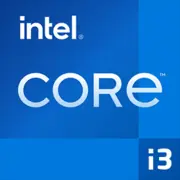Intel Core i3-6100

インテルコアi3-6100:古くなったがまだ有用?2025年の詳細分析
スカイレイクの予算プロセッサがほぼ10年後も有効か
主要特性:アーキテクチャと性能
2015年に発売されたインテルコアi3-6100は、スカイレイク世代に属します。年数が経っても、そのスペックは予算構成をする愛好家の注目を集めています。
- アーキテクチャとプロセス:14nm技術、LGA 1151ソケット。
- コアとスレッド:2コア、ハイパースレッディングによる4スレッド。
- クロック周波数:ベース — 3.7GHz(ターボブーストなし)。
- キャッシュ:3MB L3 + 512KB L2。
- 統合グラフィックス:インテルHDグラフィックス530(ベースクロック350MHz、最大1050MHz)。
- 消費電力:TDP 51W。
性能:
- Geekbench 6(2025)では、プロセッサはシングルコアで1187点、マルチコアで2317点を記録しています。比較として、現代のインテルコアi3-12100(2023)は約2400(シングル)および約9000(マルチ)を示しています。
- 主な特徴:DDR4サポート、PCIe 3.0、ビデオハードウェアアクセラレーション(HEVC 8ビット)、VT-x仮想化技術。
互換性のあるマザーボード:ソケットとチップセット
このプロセッサはLGA 1151(バージョンv1)ソケットを使用しています。適切なチップセット:
- H110:予算向けオプション(USB 3.1なし、最大2スロットRAM)。
- B150:基本機能 + M.2サポート(アダプター経由のNVMe)。
- H170/Z170:拡張機能(より多くのPCIeレーン、Z170でのRAMオーバークロック)。
2025年の選択の特徴:
- LGA 1151 v1用の新しいマザーボードはほとんど生産されていません。残存在庫の価格は$70-90から始まります(例:ASUS H110M-K)。
- BIOSのバージョンを確認することが重要です:一部のマザーボードはスカイレイクで動作するためにアップデートが必要です。
メモリ:DDR4など
Core i3-6100は次のものをサポートします:
- DDR4-2133(公式)およびDDR3L-1600(低電圧1.35V)。
- 最大容量:64GB(ただし、予算構成には8-16GBで十分です)。
推奨事項:
- DDR4はより高い帯域幅のため推奨されます。
- 例:8GB DDR4-2133(Crucial CT8G4DFS8213) — $25-30。
電源:最小限のコスト
TDP 51Wのプロセッサは強力な電源を必要としません:
- ディスクリートGPUなしのシステム:300-350Wの電源ユニットで十分です(例:be quiet! System Power 10 — $45)。
- GTX 1650レベルのGPU使用時:400-450Wのモデルを推奨します(EVGA 450 BR — $55)。
重要:安価な「ノンブランド」電源は、現代のストレージ(例えば、アダプタ経由のSSD NVMe)と不安定に動作することがあります。
2025年のi3-6100の長所と短所
長所:
- 低価格(新品の価格は$50-70)。
- エネルギー効率。
- 基本的なタスク用の統合グラフィックス。
- DDR4およびPCIe 3.0のサポート。
短所:
- コア数が2つのみ:マルチタスク時にラグ(例:ストリーミング + ゲーム)。
- PCIe 4.0/5.0、USB 3.2 Gen 2のサポートなし。
- 古い命令:AVX2がない、AI負荷のサポートが制限されている。
使用シナリオ:どこでまだ有用か?
1. オフィスタスク:文書作成、ブラウザ(10-15タブ)、Zoom。
2. マルチメディア:4Kビデオ視聴(HWデコーディング経由)、Netflixストリーミング。
3. 軽いゲーム:
- CS:GO — 中程度の設定で60FPS(720p)。
- Minecraft — 40-50FPS(1080p、統合グラフィックス)。
4. ホームサーバー:Proxmox/PlexベースのNASまたはメディアセンター。
実際の例:ユーザーはi3-6100 + 16GB DDR4 + 500GB SSDのPCを組み立て、学習に使用。Word、ブラウザ、Telegramの同時実行には対応できるが、仮想マシンを起動すると「ラグ」が生じる。
競合他社との比較
- AMD Athlon 3000G(2020):2コア/4スレッド、Vega 3。安価($60)だが、シングルコアでは弱い(Geekbench 6:約900)。
- インテルコアi3-10100(2020):4コア/8スレッド、UHD 630。中古市場で$80-100。
- 2025年の市場:新しい予算CPU(例:Ryzen 3 8300G)は$120-150で3-4倍の性能を提供。
結論:i3-6100は現代の同類に対して劣っていますが、超予算コンピュータに適しています。
構築のためのアドバイス
1. マザーボード:M.2対応モデルを探し、(PCIe経由でNVMeを接続できる)。例:ASRock B150M Pro4S。
2. メモリ:8GB DDR4は最小限、16GBが快適。
3. ストレージ:SSDは必須(Kingston A400 480GB — $35)。
4. 冷却:ボックスクーラーで十分ですが、静音性向上にはDeepcool GAMMAXX 400 V2($20)に交換。
5. アップグレード:GPU(GTX 1650)を追加すれば、基本的なゲームPCに変わります。
総括:i3-6100は誰に適しているか?
このプロセッサは以下の状況で考慮すべきです:
- 超予算構成:予算が$200-300に制限される場合。
- 一時的なソリューション:最新のコンポーネントの割引を待つためなど。
- レトロPC愛好者:古い「ハードウェア」での実験のためのシステム構築。
2025年の代替案:$120-150で新しいRyzen 3 8300Gやインテルコアi3-13100Fを購入できますが、何らかの理由でi3-6100を無料または象徴的な価格で入手した場合、まだ役立つでしょう!
価格は2025年4月のもので、情報はオープンソースおよびユーザーの経験に基づいています。
基本
CPUの仕様
メモリ仕様
GPUの仕様
その他
ベンチマーク
他のCPUとの比較
ソーシャルメディアで共有する
または当サイトへのリンクを追加
<a href="https://cputronic.com/ja/cpu/intel-core-i3-6100" target="_blank">Intel Core i3-6100</a>